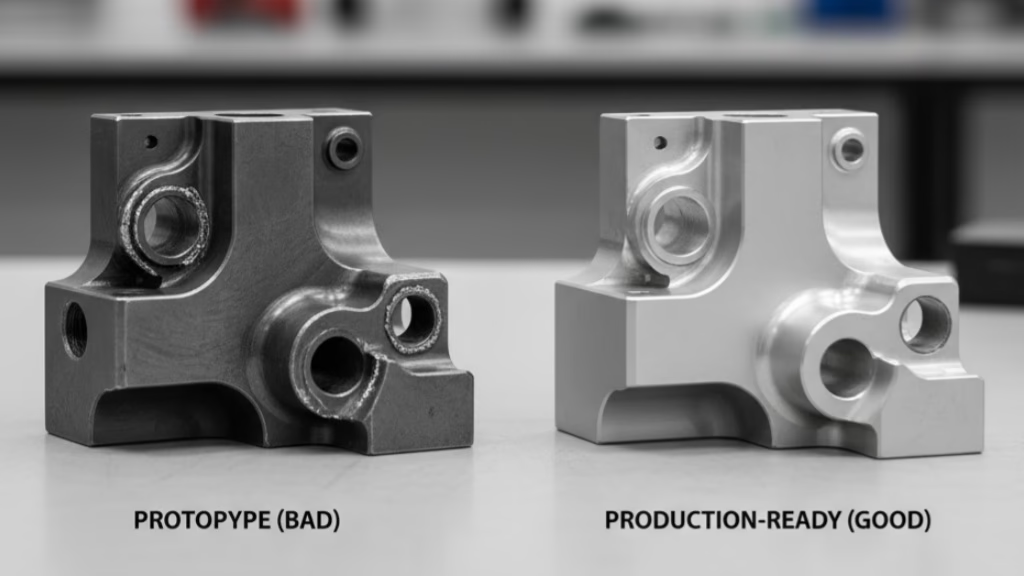Stop letting supplier failures disrupt your production schedule and destroy your profit margins. This guide provides a proven framework for transforming your machining vendor from a liability into a strategic partner. We’ll show you exactly how to build a resilient supply chain that can withstand the next global disruption.
Mitigating supply chain risks with a machining partner involves five core strategies: 1. Qualify partners on financial health and communication, not just technical skill. 2. Implement a collaborative system with joint reviews and a shared risk playbook. 3. Involve your partner in the design phase (DFM) to prevent problems. 4. Use a hybrid sourcing model, combining U.S. and nearshore production. 5. Quantify resilience with TCO and Downtime models to justify decisions.
Now that you have the core framework, let’s dive into the specific, actionable steps for each strategy. We’ll break down exactly how to implement these ideas with real-world examples and data. Read on to turn these concepts into your competitive advantage.
Strategy 1: Upgrade from Supplier Audit to Partner Qualification

Before you can collaborate, you must choose the right counterpart. For decades, a standard supplier audit was enough: check their ISO 9001 certification, inspect their equipment list, and verify their technical capabilities.
This process is still necessary, but it’s no longer sufficient. To build a resilient supply chain, you need to assess a supplier’s potential as an partner.
This requires a deeper due diligence framework that goes beyond the shop floor. Here’s what to look for:
- Financial Health: A supplier on the brink of financial trouble is a major risk. Evaluate their financial stability to ensure they can weather economic shifts without disrupting your supply.
- Their Supply Chain Resilience: A chain is only as strong as its weakest link. Ask them directly: “Where do your critical raw materials come from? What are your backup plans if that source is disrupted?”A true partner will have a clear map of their own supply chain and proactive risk mitigation strategies. This is a critical insight; shifting production to the U.S. doesn’t eliminate risk if the raw materials still come from a volatile region.
- Technology and Data Integration: In a crisis, information is everything. Can their ERP system communicate with yours? Can they provide a real-time dashboard showing your parts’ production status? Digital transparency is the foundation of a modern, collaborative partnership.
- Cultural Fit and Communication: This may be the most crucial, yet overlooked, element. Don’t just audit their processes; audit their communication culture.Ask this simple scenario question: “If you foresee a potential delivery risk, what is your standard procedure for notifying us?” Their answer will reveal everything. A partner alerts you at the first sign of trouble to solve the problem together. A vendor stays silent until it’s too late. This is the difference between a minor adjustment and a full-blown crisis, a lesson learned from a medical device client who missed a critical product launch because their technically brilliant supplier failed to communicate a raw material delay.
Facing Chronic Supplier Delays?
Tired of excuses? Our proven 4-step process ensures your high-precision parts are delivered on time, every time. See how we guarantee project success from CAD to CMM report.
Strategy 2: Implement a Collaborative Operating System
Once you’ve identified a qualified partner, the relationship needs a structure to thrive.
Moving from a transactional exchange to a symbiotic partnership requires a shared “operating system” that embeds risk management into your daily interactions. This isn’t about adding more meetings; it’s about making your interactions more meaningful.
- Joint Business Reviews (JBRs): Go beyond negotiating prices. Hold quarterly reviews where both your teams discuss market forecasts, review performance against shared metrics, and jointly plan for future capacity needs.
- A Shared Risk Playbook: Don’t wait for a crisis to decide how you’ll react. Work together to identify potential failure points—a specific material shortage, a regional logistics bottleneck—and create a “Plan B” before you need it. Define the triggers and outline the exact steps both parties will take.
- Radical Transparency: The goal is to create a “no surprises” environment. This requires an agreement to share critical data, such as your demand forecasts and their production load. The more visible the entire process is, the earlier you can spot and address potential issues.
Strategy 3: Shift Risk Mitigation into the Design Phase

The most effective way to de-risk your supply chain isn’t by firefighting production issues; it’s by preventing them from ever happening.
This means bringing your manufacturing partner into the conversation much earlier—during the design phase. As Professor Willy C. Shih of Harvard Business School notes, “For too long, managers have focused on the unit price of components and forgotten the total cost.”
The highest total costs often originate from design decisions made in a vacuum.
Involving your partner in Design for Manufacturability (DFM) is a strategic imperative. A great machining partner won’t just follow a blueprint; they will challenge it constructively.
We saw this firsthand with an aerospace client designing a complex component milled from a single aluminum block. The design was elegant but expensive and slow to produce. By involving our engineering team early, we proposed a new approach: splitting the part into two interlocking, simpler components.
The result? A 40% reduction in total cost and a 60% shorter lead time, all while improving the part’s overall performance. That is the power of a true partnership. It moves the relationship from a simple service transaction to a collaborative effort focused on achieving the best possible outcome.
Strategy 4: Build a Hybrid Inventory and Logistics Network
The goal of resilience isn’t to eliminate all risk—that’s impossible. It’s about building a smart, flexible system that can absorb shocks.
This means moving away from a rigid “just-in-time” philosophy toward a more balanced “just-in-time, just-in-case” model. For your machined components, this is best achieved through a hybrid sourcing strategy.
Reshoring every single part to the U.S. is not a practical or cost-effective solution. Instead, think of your supply chain as an investment portfolio, diversifying your assets to balance risk and return.
- Core and New Product Components: For your most critical, complex, or newly developed parts—the “crown jewels” of your product—partner with a U.S.-based manufacturer. The slightly higher unit cost buys you speed, agility for design changes, and a secure supply for the components that matter most.
- Mature, High-Volume Components: For stable, high-volume parts, a nearshore strategy with a partner in Mexico, for instance, can provide a significant cost advantage while still reducing the logistical nightmares of overseas shipping.
The most advanced U.S. manufacturing partners can act as your “North American Control Tower.” They can manage your entire portfolio, producing the most complex parts in their U.S. facility while coordinating with their own trusted network in Mexico for the high-volume work.
This gives you a single point of contact, U.S.-level quality control and project management, and a blended cost structure that is both competitive and highly resilient.
This approach can be combined with modern inventory strategies like Vendor-Managed Inventory (VMI), where your partner takes responsibility for maintaining agreed-upon stock levels at or near your facility.
Risk Mitigation Strategy Summary
| Strategy | Core Action | Primary Benefit |
|---|---|---|
| Partner Qualification | Assess financial health & communication culture | Prevent foundational partner failure |
| Collaborative OS | Implement JBRs & shared risk playbooks | Enable proactive, not reactive, responses |
| Early Design (DFM) | Integrate partner into design phase | Eliminate risks before production starts |
| Hybrid Network | Blend US & nearshore sourcing | Balance cost, speed, and security |
| Quantify Value | Use TCO & CoD models for reporting | Gain internal buy-in from leadership |
Strategy 5: Quantify the Value of Resilience for Your CFO
Perhaps the biggest hurdle a supply chain leader faces isn’t a supplier; it’s the internal conversation with the CFO. How do you justify a partnership that might have a higher piece-part price?
You do it by speaking their language: data. You must build a business case that proves resilience is a competitive advantage, not just an expense.
Yossi Sheffi, Director of the MIT Center for Transportation & Logistics, puts it perfectly: “Resilience is not about preventing disruptions… it’s about building the capacity to survive, adapt, and grow… It may seem inefficient in the short term, but it is critical for long-term survival.”
Here is your toolkit for making that case:
- Calculate the Total Cost of Ownership (TCO): Don’t just present the unit price. Use the TCO formula to show the full picture. TCO = Price + Logistics + Quality + Risk The Risk variable is your most powerful tool. Assign a dollar value to the potential cost of a line-down situation, expedited freight, and engineering time spent fixing supplier errors. This turns an abstract risk into a concrete financial figure.
- Model the Cost of Downtime (CoD): The auto industry estimates that a stopped production line costs over $22,000 per minute. While your number may be different, calculating your own CoD provides a powerful anchor for the conversation.
- Highlight the Hidden Costs: Remind your leadership that the price on a purchase order is just the tip of the iceberg. Boston Consulting Group (BCG) estimates that hidden costs—like shipping delays, quality rejects, and increased inventory—can add 15-25% to the cost of sourcing from a low-cost overseas supplier.
- Share the Cautionary Tale: Use a real-world example, like the industrial equipment company that was lured by a 35% price reduction from an overseas vendor. After factoring in production halts, quality failures, and emergency air freight, their actual TCO was 50% higher than it was with their original, reliable U.S. partner. This story illustrates that the cheapest option is rarely the least expensive one.
Conclusion: Your Supply Chain, Your Fortress

In an era defined by volatility, the strength of your business is no longer measured by how lean you can make your operations, but by how resilient they are.
The relentless pursuit of the lowest possible unit cost has created fragile, high-risk supply chains that are one unforeseen event away from collapse. Mitigating these supply chain risks requires a new vision.
The five strategies outlined above are more than just a checklist; they represent a fundamental shift in philosophy. They are about transforming your relationships with your core machining suppliers from a potential liability into a powerful asset. Your choice of a manufacturing partner directly defines the integrity of your entire supply chain.
A true partner does more than just make parts. They offer insights that lower your total costs, provide transparency that eliminates surprises, and collaborate to solve problems before they can stop your production line.
They help you build a supply chain that is not a weakness to be defended, but a competitive fortress that allows you to navigate disruption better than your competition.
Ready to Build a Resilient Partnership?
You’ve seen the strategy. Now, partner with a team that lives it. Let our experts provide the precision, reliability, and proactive communication your supply chain deserves.
References & Notes
[1] Total Cost of Ownership (TCO): A financial estimate intended to help buyers and owners determine the direct and indirect costs of a product or system. It includes not just the initial purchase price but all costs associated with its use and maintenance over its lifetime, including the quantifiable cost of risk.
[2] Expert Source (Yossi Sheffi): Professor Yossi Sheffi is the Director of the MIT Center for Transportation & Logistics and a leading global expert on supply chain management, resilience, and systems optimization. His work provides an authoritative academic basis for investing in supply chain resilience.




